全文HTML
--> --> -->长余辉材料的研究时间较长, 其发现更是可以追溯到古代. 对于长余辉发光的模型, 不同的科学家给出了不同的见解, 发光过程和机理本身也较为复杂, 且长余辉的各种发光性质易受到合成温度、稀土离子掺杂浓度、还原气氛和基质材料等的影响[14-18], 其中稀土离子的不同浓度对余辉时间影响最为显著, 稀土离子的浓度范围广, 且双掺杂的稀土离子在尽可能少的实验中寻找最优的样品更加困难. 因此急需寻找一种高效、快捷的方式获得最佳样品, 也是科研人员研究的重点之一.
在长余辉材料中, 硅酸盐体系优于铝酸盐体系不具有的防水性能, 其优异的物理和化学性质, 低的成本等受到科研人员的广泛关注. 其中, Sr2MgSi2O7体系的蓝色荧光粉在Eu2+和Dy3+共掺杂时具有显著的余辉性能. 虽然稀土掺杂的Sr2MgSi2O7体系已经有大量报道, 但是应用实验优化的方法对该体系进行研究, 是更为科学的一种方法[14-21].
为了进一步延长Sr2MgSi2O7体系的有效余辉时间, 需要确定Eu2+和Dy3+共掺杂的最优浓度. 文献[22]选用试验优化设计的方法对实验进行全程优化. 本文应用试验优化设计中的二次通用旋转组合设计[15-24], 建立了Sr2MgSi2O7:Eu2+, Dy3+掺杂浓度和有效余辉时间的二次回归方程[23]. 再应用遗传算法, 计算得到Sr2MgSi2O7:Eu2+, Dy3+最优稀土离子掺杂浓度的理论最优值[25]. 高温固相法进行最优样品制备. 用X射线衍射(XRD)表征最优样品的物相, F-4600测试样品的余辉衰减, 大连海事大学自主研制的DMU-450自动加热控温系统测量样品的热释发光谱, 探讨了长余辉发光的机理.
2.1.样品的合成与表征
将上述化学原料试剂按照精确的化学计量比进行称量用于合成目标产物Sr2MgSi2O7, 称量后的试剂放进玛瑙研钵中各研磨30 min混合均匀, 将研磨后的材料放在Al2O3坩埚内并置于装有碳粉的大坩埚中, 并置于马弗炉中, 在CO气氛下1250 ℃保持3 h. 待样品随炉冷却至室温后取出, 研磨成粉末.应用日本岛津XRD-6000粉末衍射仪对样品的纯度和结构进行分析, X射线波长为1.5406 ?, 辐射源为Cu靶K

2
2.2.二次通用旋转组合设计
通过查阅文献对Sr2MgSi2O7体系中Eu2+和Dy3+的掺杂浓度范围初步确定为0.5 mol%—5 mol%和1 mol%—10 mol%[23], 完成二次通用旋转组合设计. 在编码空间中二次通用旋转组合设计由于其具有旋转性和通用性等优点, 因此在应用二次通用旋转组合设计进行实验优化时需要将各因素先进行编码, 得到的Sr2MgSi2O7:Eu2+, Dy3+的自然因素水平编码表, 如表1. 从表1可知本次实验的全程优化选取Eu2+和Dy3+掺杂浓度的5个水平. 其中编码水平分别为0, ±1和±r.| Zj(xj) | x1(Eu2+)/% | x2(Dy3+)/% |
| Z2j(r) | 5 | 10 |
| Z0j + $\varDelta_j$(1) | 4.341 | 8.682 |
| Z0j(0) | 2.75 | 5.5 |
| Z0j – $\varDelta_j$(–1) | 1.159 | 2.318 |
| Z1j(–r) | 0.5 | 1 |
| $\varDelta_j$ = (Z2j – Z1j)/2r | 1.591 | 3.182 |
| xj = (Zj – Z0j)/$\varDelta_j$ | x1 = (Z1 – 2.75)/1.591 | x2 = (Z2 – 5.5)/3.182 |
表1自然因素水平编码表
Table1.Natural factor level coding table
根据表1自然因素水平编码表进行二次通用旋转组合设计共进行13组实验, 实验方案和有效余辉时间的结果列于表2.
| Number | x0 | x1 | x2 | x1x2 | x12 | x22 | Afterglow time/s |
| 1 | 1 | 1 | 1 | 1 | 1 | 1 | 132 |
| 2 | 1 | 1 | –1 | –1 | 1 | 1 | 80 |
| 3 | 1 | –1 | 1 | –1 | 1 | 1 | 212 |
| 4 | 1 | –1 | –1 | 1 | 1 | 1 | 184 |
| 5 | 1 | r | 0 | 0 | r2 | 0 | 116 |
| 6 | 1 | –r | 0 | 0 | r2 | 0 | 290 |
| 7 | 1 | 0 | r | 0 | 0 | r2 | 172 |
| 8 | 1 | 0 | –r | 0 | 0 | r2 | 138 |
| 9 | 1 | 0 | 0 | 0 | 0 | 0 | 141 |
| 10 | 1 | 0 | 0 | 0 | 0 | 0 | 104 |
| 11 | 1 | 0 | 0 | 0 | 0 | 0 | 102 |
| 12 | 1 | 0 | 0 | 0 | 0 | 0 | 101 |
| 13 | 1 | 0 | 0 | 0 | 0 | 0 | 105 |
表2二次通用旋转组合设计实验方案及余辉时间
Table2.Quadratic general rotation combination design experimental scheme and afterglow time.
3.1.二次通用旋转组合设计有效余辉时间分析
图1为Sr2MgSi2O7体系的Eu2+和Dy3+在经过UV365 nm紫外线激发5 min后测试得到的衰减曲线, 可以看出所有样品在50 s内呈现快速衰减, 其中6号样品和3号样品的有效余辉光时间最长, 将余辉衰减曲线按照初始强度衰减的10%作为有效余辉时间填入表2第8列. 图 1 Eu2+/Dy3+的余辉衰减曲线
图 1 Eu2+/Dy3+的余辉衰减曲线Figure1. Afterglow attenuation curve of Eu2+/Dy3+.
2
3.2.二次通用旋转组合实验设计数据分析
根据以上二次通用旋转组合设计的实验结果及分析, 可以通过自然因素编码空间得到有效余辉时间的二元二次回归方程:| Afterglow time/s | |||
| 方差或 t 统计量 | 显著性水平$\alpha$ | 显著性水平$\alpha$ | |
| x0 | 14.490 | 0.001 | *** |
| x1 | 5.193 | 0.01 | ** |
| x2 | 1.546 | 0.2 | * |
| x1x2 | 0.703 | 0.6 | Insignificant |
| x12 | 6.116 | 0.01 | *** |
| x22 | 2.408 | 0.2 | * |
| F回 | 18.07 | 0.001 | *** |
| 注: ***极显著水平($\alpha$ ≤ 0.01); **显著水平($\alpha$ ≤ 0.1); *较显著水平($\alpha$ ≤ 0.25). | |||
表3显著性检验分析
Table3.Significant test analysis.
因此编码空间中有效余辉时间Eu2+和Dy3+的二元二次回归方程可以优化为
2
3.3.最优样品的晶体结构特性
图2为Sr2MgSi2O7:0.5 mol%Eu2+/1.0 mol%Dy3+和数据库中标准数据卡片Sr2MgSi2O7的JCPDS#75-1736的XRD图谱. 从图中可以看出制备的最优样品的衍射峰位置与标准数据卡片相比基本一致, 且无其他杂相出现, 这说明本文中制备的最优样品为纯相, 也说明Eu2+和Dy3+的共掺杂被Sr2MgSi2O7中的Sr2+离子完全取代格位, 且样品最优的掺杂浓度并未对Sr2MgSi2O7的晶体结构造成显著的影响.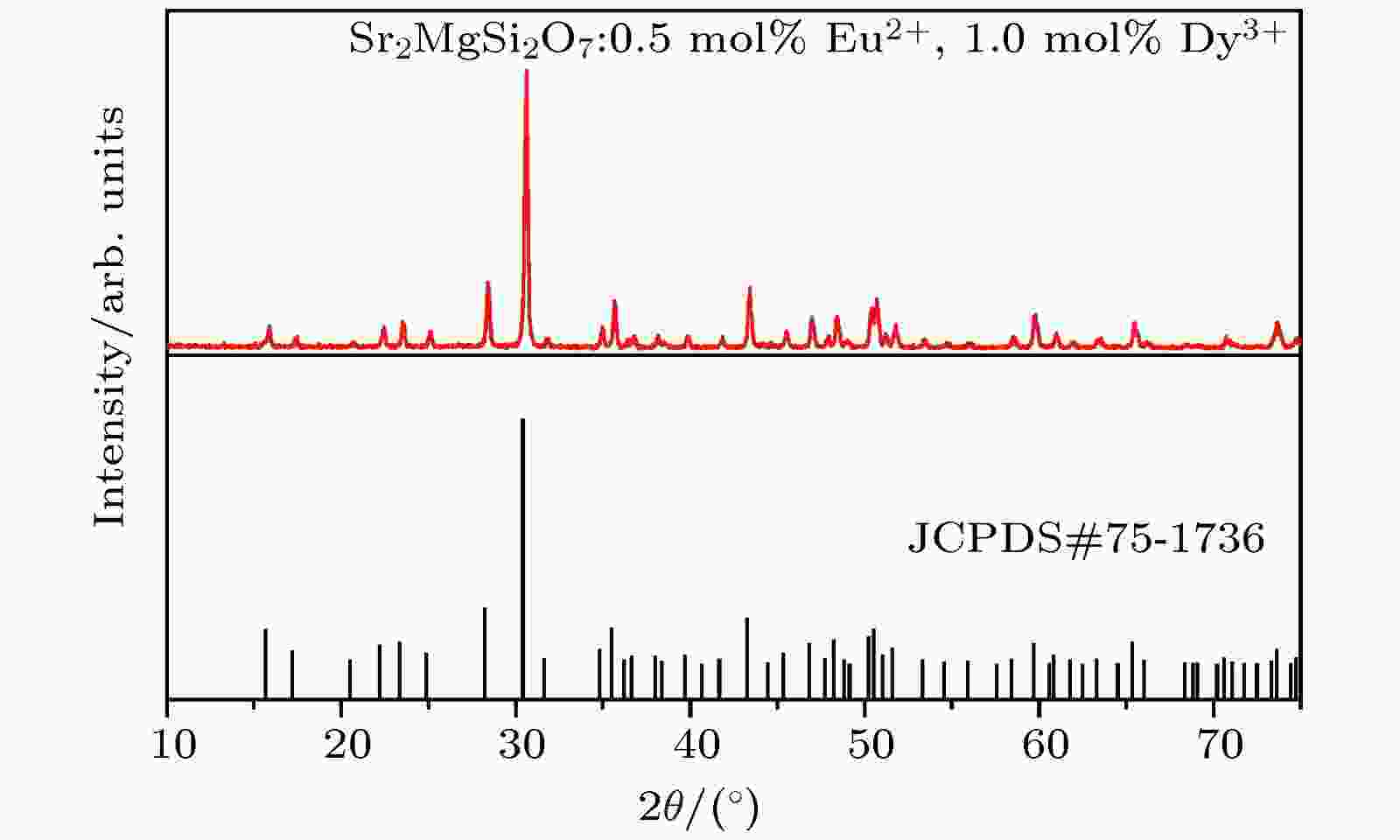 图 2 Sr2MgSi2O7:0.5 mol% Eu2+, 1.0 mol% Dy3+和标准数据卡卡片JCPDS#75-1736的XRD图谱
图 2 Sr2MgSi2O7:0.5 mol% Eu2+, 1.0 mol% Dy3+和标准数据卡卡片JCPDS#75-1736的XRD图谱Figure2. XRD pattern of Sr2MgSi2O7:0.5 mol% Eu2+, 1.0 mol%Dy3+ and standard data card card JCPDS#75-1736.
2
3.4.最优样品的荧光激发和发射光谱
图3为最优样品Sr2MgSi2O7:0.5 mol%Eu2+, 1.0 mol% Dy3+的荧光激发和发射光谱, 样品的激发和发射光谱由宽带构成, 激发光谱位于250—450 nm, 其峰值位置位于370 nm, 样品在370 nm激发下具有强烈的蓝色发射, 发射中心位于465 nm, 这归因于Eu2+的4f65d1—4f7跃迁[26].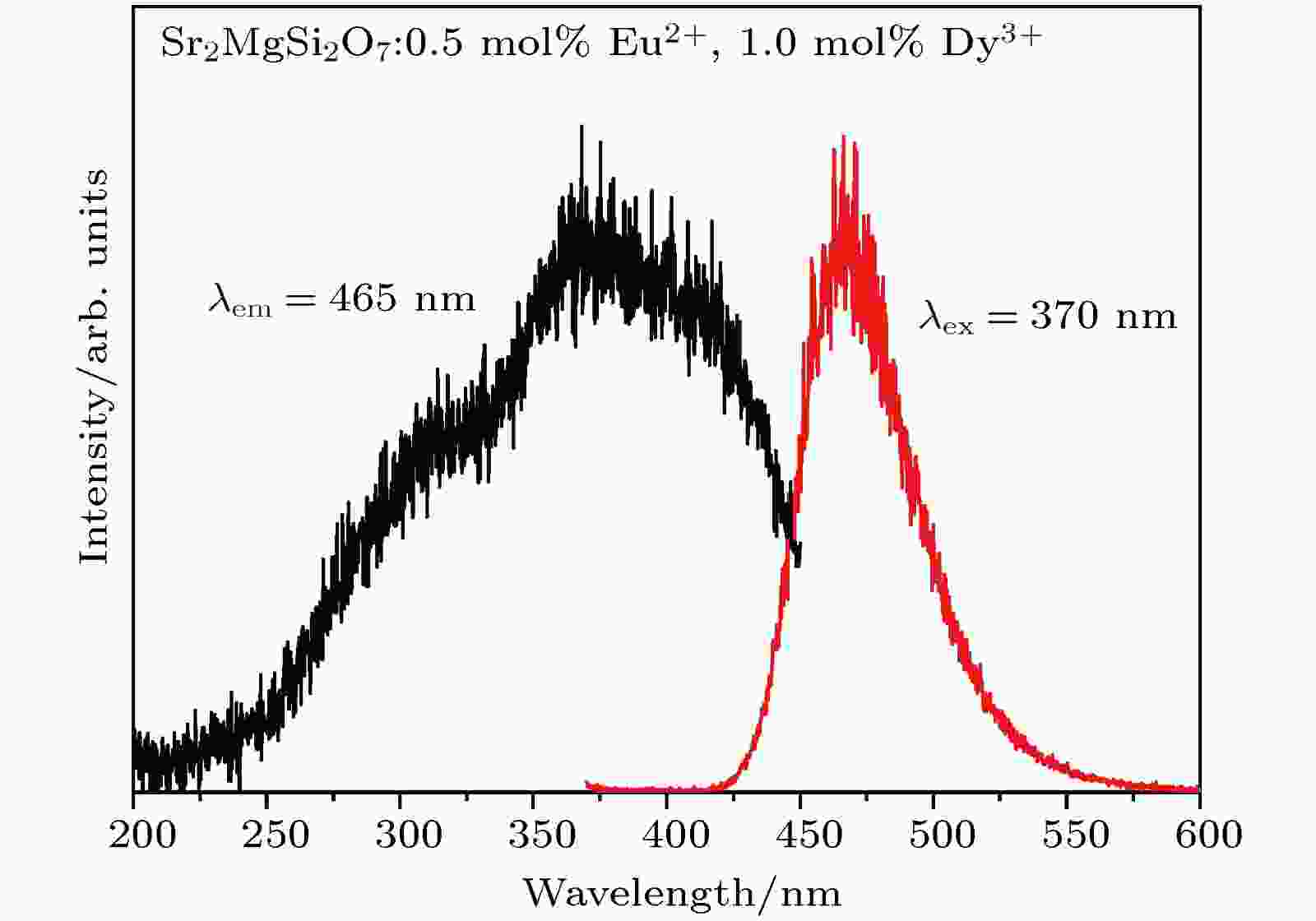 图 3 Sr2MgSi2O7:0.5 mol% Eu2+, 1.0 mol% Dy3+的荧光激发和发射光谱
图 3 Sr2MgSi2O7:0.5 mol% Eu2+, 1.0 mol% Dy3+的荧光激发和发射光谱Figure3. Fluorescence excitation and emission spectroscopy of Sr2MgSi2O7:0.5 mol% Eu2+, 1.0 mol% Dy3+.
2
3.5.最优样品的余辉衰减曲线
图4为最优样品的余辉衰减曲线以及应用华为相机在感光度ISO3200, 曝光时间1/20 s下拍摄的样品在紫外灯下照射5 min和停止照射1, 3和6 min的照片. 从图中可以计算出有效余辉时间为333 s, 与应用二次通用旋转组合设计计算得到的理论值321 s接近, 这也证明了实验优化设计在本工作中的应用是合理的. 为进一步得到最优样品的余辉性能参数, 我们应用单指数方程


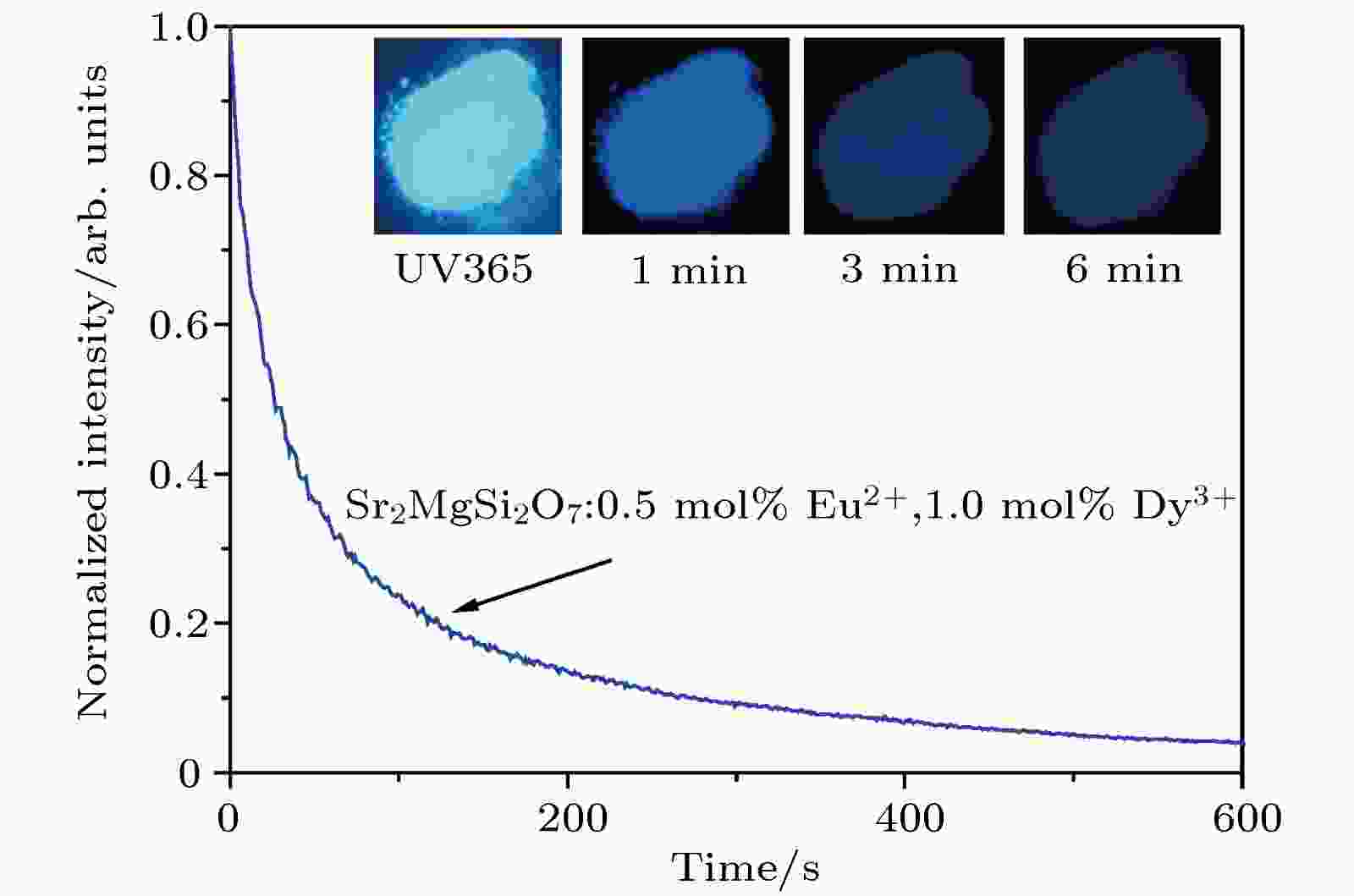 图 4 Sr2MgSi2O7:0.5 mol%Eu2+, 1.0 mol% Dy3+的余辉衰减曲线
图 4 Sr2MgSi2O7:0.5 mol%Eu2+, 1.0 mol% Dy3+的余辉衰减曲线Figure4. Afterglow decay curve of Sr2MgSi2O7:0.5 mol% Eu2+, 1.0 mol% Dy3+.
2
3.6.最优样品的热释发光光谱
根据文献[27, 28]建立的模型, 对样品的热释发光谱进行计算得到样品的陷阱深度为















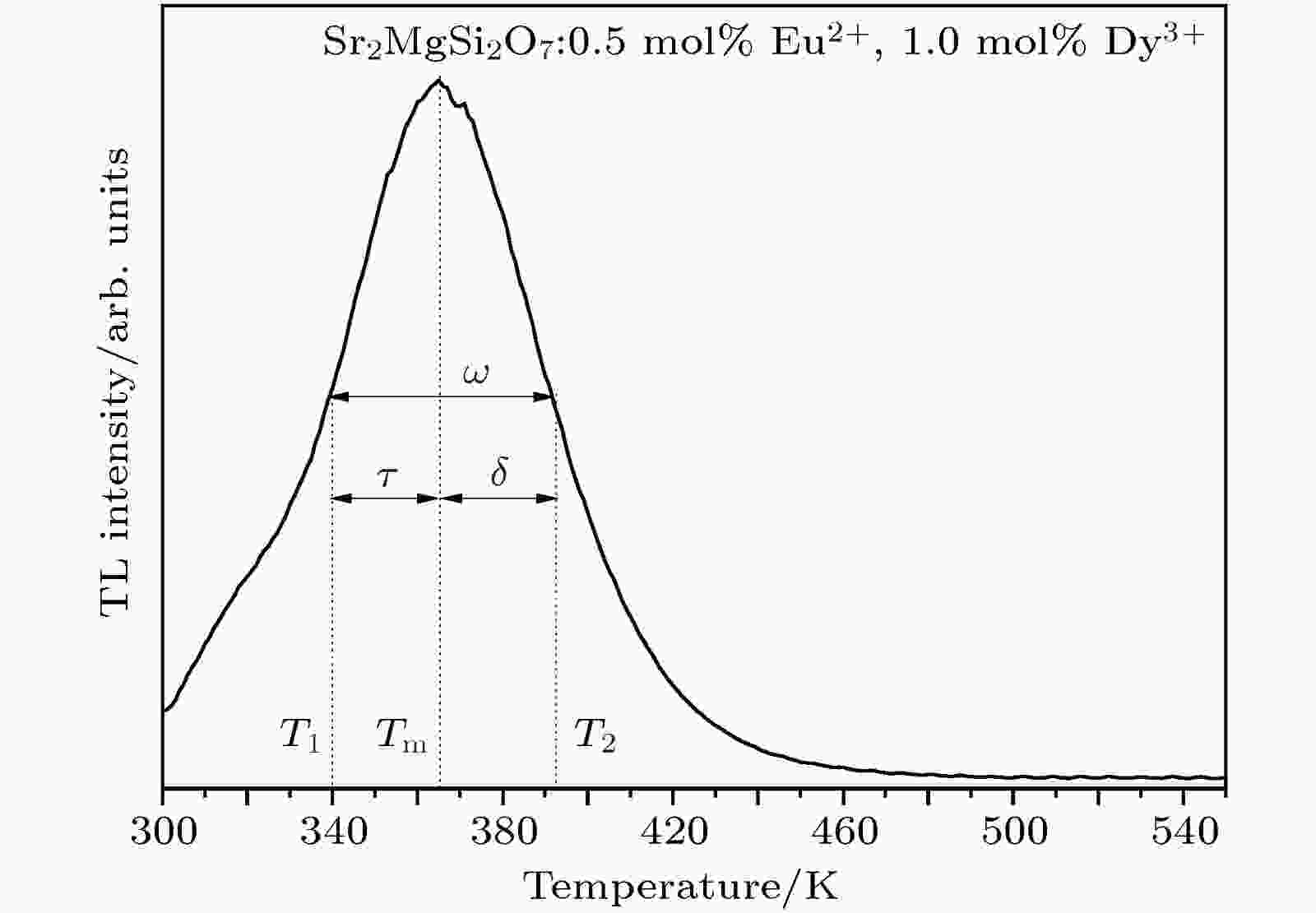 图 5 Sr2MgSi2O7:0.5 mol%Eu2+, 1.0 mol% Dy3+的热释发光光谱
图 5 Sr2MgSi2O7:0.5 mol%Eu2+, 1.0 mol% Dy3+的热释发光光谱Figure5. Thermoluminescence spectroscopy of Sr2MgSi2O7:0.5 mol% Eu2+, 1.0 mol% Dy3+.
根据文献[27, 28]建立的模型, 可以得到表3数据, 由(5)式可以计算得到表4数据.
| T1/K | Tm/K | T2/K | $\tau$/K | $\delta$/K | $\omega$/K | ${\mu _{\rm g}}$/K | ${E_\tau }$/eV | ${E_\delta }$/eV | ${E_\omega }$/eV | E/eV |
| 339* | 365 | 393 | 26 | 28 | 54 | 0.528 | 0.673 | 0.701 | 0.690 | 0.688 |
表5Sr2MgSi2O7:0.5 mol% Eu2+, 1.0 mol% Dy3+的陷阱深度参数
Table5.Trap depth parameter of Sr2MgSi2O7:0.5 mol% Eu2+, 1.0 mol% Dy3+.
| $\tau$ | $\delta$ | $\omega$ | |
| ${c_\alpha }$ | 1.81 | 1.71 | 3.54 |
| ${b_\alpha }$ | 2 | 0 | 1 |
表4文献[27, 28]的模型陷阱深度参数
Table4.Model trap depth parameter in Refs. [27, 28].
通常认为, 当热释发光谱主峰的峰值位置位于350 K左右时, 在室温下易于表现出优异的长余辉现象. 当陷阱深度比较低时, 同样载流子会迅速释放, 因而不易产生优秀的长余辉现象[25,29]. 其中最优样品Sr2MgSi2O7:0.5 mol% Eu2+, 1.0 mol% Dy3+的热释光谱峰值位置为365 K, 计算得出陷阱深度为0.688 eV (见图5和表5). 这与文献中给出的产生优异长余辉现象一致, 也充分证明应用二次通用旋转组合计算并制备得到的最优样品Sr2MgSi2O7:0.5 mol%Eu2+, 1.0 mol%Dy3+是可信的.
2
3.7.长余辉光发光过程
根据以上实验分析及得出的优异效果, 根据能级结构, 提出了Eu2+作为Sr2MgSi2O7基质发光中心的长余辉发光过程, 如图6所示, 为稀土离子掺杂基质作为发光中心以及表现出长余辉的现象的电子俘获过程提供参考.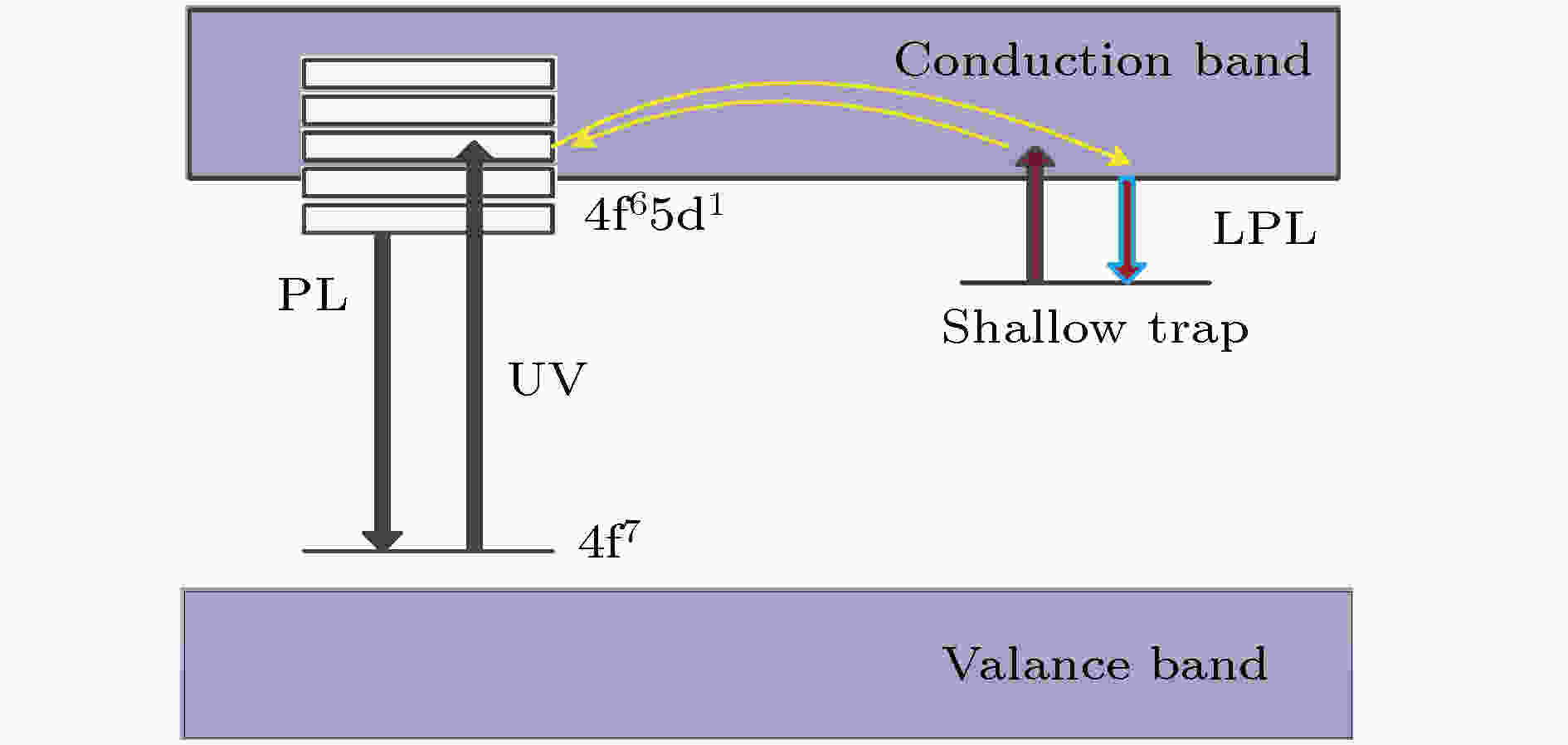 图 6 长余辉发光过程的简单模型
图 6 长余辉发光过程的简单模型Figure6. Simple model of long afterglow luminescence process.
当样品受到外界UV辐射时, 通过跃迁的方式到激发态产生电子, 一部分电子返回到Eu2+的基态与空穴进行复合从而产生Eu2+的特征发射峰; 剩下的电子被陷阱俘获并暂时存储在其中. 受到热扰动时, 电子逸出陷阱并到达发光中心以一定波长的方式释放出来, 产生长余辉现象.
